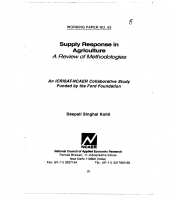Supply Response in Agriculture : A review of methodologies
Deepali Singhal Kohli
June 1996
This paper reviews methodologies that have been in vogue for some decades in studies concerning supply response in agriculture. In supply response studies, one has to view output supply and factor demand functions (and perhaps, institutional constraints) in a simultaneous equations framework. It is in this context that different models that are generally used in such studies are evaluated. These include models using different functional forms such as the Nerlovian model, i.e. an adaptive expectations-partial adjustment framework, the multinomial logit model, the time series-cross section model, the profit function model, and the frontier production function model.
This paper is part of an ICRISAT-NCAER collaborative study on “Changes in cropping Patterns and Resource Use Efficiency in the Semi-Arid Tropic of India: The Role of Price and Non-Price Factors”. We are grateful to the Ford Foundation for funding this study and for presenting an opportunity to work collaboratively with ICRISAT. The NCAER team is lead by Dr. Ashok Gulati, while Dr. T.G. Kelly as the project leader at ICRISAT. The author has worked under the guidance of both team leaders.
Agriculture and Rural Development







